Book Reviews by Title
Book Reviews by Title
– Father Thomas A. Thompson, S.M.
List of Titles
Celebrations for the Millennium: 1997- 1999
Commentary on the Rule of Life of the Society of Mary
The Family Rosary Crusade Handbook: Guidelines for Diocesan Sponsored Family Rosary Crusade
Gateway of Life: Orthodox Thinking on the Mother of God
God Alone: The Collected Writings of St. Louis Marie De Montfort
Jesus Living In Mary: Handbook of the Spirituality of St. Louis Marie de Montfort
Mary in Early Christian Faith and Devotion
Mary Is for Everyone: Essays on Mary and Ecumenism
The Mother of the Lord: Memory, Presence, Hope
New Religious Movements in the Catholic Church: Grass Roots, Mission and Evangelization
Praise for All Seasons: The Hymns of James Quinn S.J.
Servants of the Magnificat: The Canticle of the Blessed Virgin and the Consecrated Life
Celebrations for the Millennium
1997: Christ; 1998: "Come, Holy Spirit"; 1999: God the Father.
-Totowa, New Jersey: Catholic Book Publishing Company, 1997-99
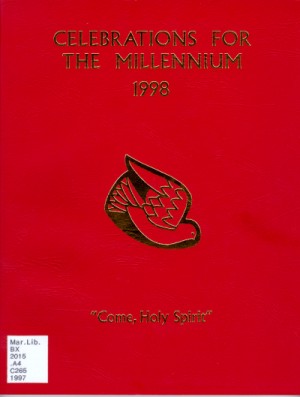
These three volumes are offered by the Central Organizing Committee for the Great Jubliee of the Year 2000. For each of the years, materials for liturgy and prayer services to underline the themes of the preparation period for the millennium, as outlined in On the Coming Third Millennium. The structure of the each book is similar: formularies for Masses (many newly composed); texts for the General Intercession; prayers before the Blessed Sacrament; texts for prayer vigils and the celebration of the Word; penitential celebrations; litanies; Marian devotions. Some of the material can be found elsewhere (e.g., the Sacramentary, the Collection of Masses of the Blessed Virgin Mary); but much of the material, especially for the prayer services and devotions, is newly composed or taken from sources not readily available.
One feature is several new litanies, which make possible a slow rhythmic interaction of expressions of praise and petition, and can be used as part of a service or processional chant. The invocations of the litanies provide many suggestions for prayer, catechesis, and illustration. In the 1997 volume, there are three new litanies referring to Christ. The 1999 volume contains three litanies for the Blessed Virgin Mary. In addition to the Litany of Loreto, there is the "Litany of Mary, Queen," (which appeared in the "Order of Crowning an Image of Blessed Virgin Mary" [English translation, 1987]). The third, "Litany of Our Lady of Hope," provides variety in structure, with contemporary titles, illustrating Mary as disciple and model of the Church; it speaks of Mary's identification with the oppressed and marginalized, and describes her presence as "prayerful, welcoming, shining, active."
The 1999 volume provides examples of Reconciliation Services based on different themes: Lord, Our Father; the Father of Mercies; the Fountain of Love. Suggestions for "examination of conscience" are given, one based on the Parable of the Prodigal Son, and the other on the Beatitudes.
The Marian section, a small part of the total work, provides material not previously accessible to most catechists and liturgy planners. Texts for the revered hymn of the Eastern Church, the Akathist, are provided (four major sections) together with an opening invocation, Scripture readings, intercessions, and "workable" suggestions for their use. The texts could be used during Advent or as a prayer service on the solemnities of Mary, Mother of God and of the Annunciation.
The 1998 volume has an innovative Rosary service based on the mysteries of "the Holy Spirit," i.e., the Holy Spirit's presence at the Annunciation, Visitation, the Cross, Pentecost, and in the Hearts of the Christians. The format consists of announcemnt of the mystery, Our Father, ten Hail Marys (the first part only, but with the possibility of including a phrase referring to the mystery under consideration), with the second part of the Hail Mary recited only at the end of the Hail Marys. Twenty-six years ago, the American bishops' Behold Your Mother urged adaptation and experimentation with the rosary-type of prayer. However, since no examples from any authoritative source were provided, experimentation with the rosary was frequently misunderstood and resisted.
The use of the resources are not "time-dated," that is, limited to the years for which they were originally intended; they will enrich liturgies and prayer services well into the next millennium. The postconciliar period has given great attention to the liturgical texts, but provided very little guidance for the development of prayer services. These books provide many texts but also patterns, which can be adapted, for vigils, reconciliation services, Marian programs. These books should be in every sacristy and in the offices of religious educators and liturgical planners.
Commentary on the Rule of Life of the Society of Mary
-Dayton, OH: North American Center for Marianist Studies, 1994.
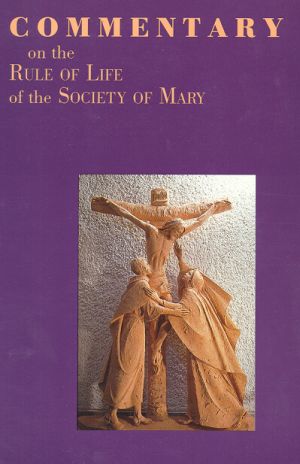
After Vatican II, all religious congregations responded to the Council's call for greater fidelity to the Gospel and to their founding charism by reviewing and rewriting the basic rule by which they were governed. The Society of Mary (Marianists) began its revision in 1961 in anticipation of the Council's request. The process took twenty-two years and was completed on June 29, 1983, with the approval of the Rule of Life by the Congregation of Religious.
In response to a request from the Marianist General Administration, Bro. Ambrogio Albano, S.M., engaged the services of forty-three Marianists to write articles dealing with various facets of the Rule of Life. The contributors come from various cultures and backgrounds; each attempts to explain and enlighten some aspect of the recently approved document. The editor notes that, because of the varied background of the contributors, "it is inevitable that a certain pluralism reflects options, directions, sensibilities which do not correspond totally, perhaps, to those long used to seeing the realities of the Society of Mary through the prism of certain traditions." Nevertheless, there is, as Marianists are wont to say, "unity in diversity."
Most articles have an historical dimension which includes references to the writings of the founder of the Society of Mary, William Joseph Chaminade (1763-1850). The essays deal first of all with topics common to all forms of the religious life "Vows," "Religious Profession." Others deal with administrative aspects of the congregation: "Administration," "Authority," "The Rule of Life," "The Three Offices," "General Chapters." Some topics are unique to the Society and its history: "Mixed Composition," "Family Spirit," "Consecration to Mary," "The Spirit of Faith," "Meditation." Still other topics indicate the new vocabulary which has entered through developments in the Church: "Dialogue," "Participation," "Peace and Justice."
This commentary on Marianist life and spirituality is the culmination of almost a century of Marianist studies dedicated to recovering the thought of the founder. But it is also a hermeneutical key for interpreting Marianist spirituality for and transmitting this spirituality to new cultures, vastly different from nineteenth-century France in which it originated.
The Family Rosary Crusade Handbook: Guidelines for Diocesan Sponsored Family Rosary Crusade
-The Family Rosary, Inc., 1987
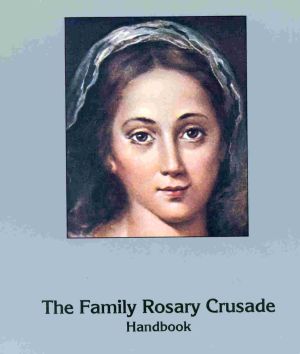
The Family Rosary; Inc. has recently published The Family Rosary Crusade Handbook, by Father Patrick Peyton, C.S.C., the story of the Family Rosary Crusade begun by Father Peyton forty-five years ago. By a happy coincidence, the forty-fifth anniversary of the Family Rosary Crusade occurred during the Marian Year.
Sister Mary J. Buckler; R.S.M., executive director of the Family Rosary; Inc., calls the book "Father Peyton's legacy to us." I believe this is so not only because it represents the fruits of a life spent propagating the rosary, but also because it is the most highly recommended book that I know of. Besides the usual approbations, it is highly recommended by Luigi Cardinal Dadaglio, president of the Central Committee for the Marian Year, and seven other cardinals as well as a host of archbishops and bishops.
Essentially, the book is a "how-to" guide, since it is the fruit of Father Peyton's experiences and tells step by step how to conduct a Family Rosary Crusade. However, there are many other features not in the "how-to" category that should endear it to many readers.
The first part, "Organization," is most important since it details how to organize a Family Rosary Crusade, and even provides a sample letter that any bishop might send to all his people to encourage such a crusade. After "Organization" comes "The Exegesis: The Mysteries of the Rosary in the Light of scripture," followed by selections called "Sources," from various important theologians, including Pope John Paul I Cardinals Herrera and de Lubac, S.J., Monsignor Gerard Philips; and Professor Karl Rahner, S.J. Included is one of our most beloved modem spiritual writers, Father Basil Pennington, O.C.S.O. There is also a selection by a Protestant member of the Ecumenical Society of Our Lady in England, entitled "The Rosary- a Representative Image of Reality." The section concludes with Father Peyton's own testimony to the Family Rosary followed by "Model Prayers of the Faithful."
The book's fourth section, "Teachers' Sources," includes a message to teachers from Father Peyton, suggested classroom projects, a sample essay assignment, and two examples of essays by children in the seventh and eighth grades.
The appendix should not be over-looked. It gives samples of all the materials used in the book and includes remarks about the libraries of Family Rosary, Inc. and Family Theater, Inc.
Gateway of Life: Orthodox Thinking on the Mother of God
-Mary B. Cunningham
-Yonkers: St. Vladimir's Seminary Press, 2015
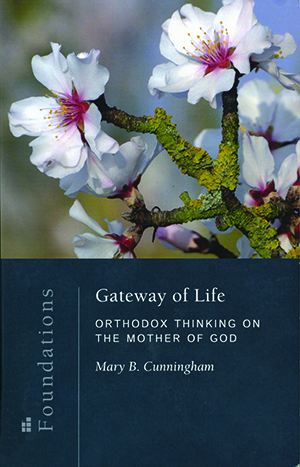
The Virgin Mary is central to the Orthodox Church: She is prominent in its liturgical texts, in the hymnody of the liturgy, and in its iconography. References to the Virgin Mary in the liturgical texts of the Eastern Church occur more frequently than in the Western Church. The major Marian feasts celebrated in the Western Church originally came from the East.
In Orthodoxy, liturgy, Scripture, theology, the apocrypha, and hymnology are all intertwined. We from the West stand in admiration of the place the Virgin Mary has in the Eastern Church. Yet, without some explanation of the theological foundation for this Marian devotion, it is difficult for us to come to a deeper understanding and appreciation of the role of Mary in the Eastern Church. It is precisely here that Mary Cunningham’s book is of inestimable value.
Authoritative sources for Orthodoxy are the Christian Scripture (the Greek Septuagint translation of the Hebrew) and also the apocrypha, especially the Protoevangelium of James. Central to Orthodoxy the is integration of the Old and New Testaments: the Old Testament presents individuals, events, and symbols — types or allegories — that find their completion and fulfillment in the New Testament. St. John Damascene describes Old Testament types as “images of the future.” Events, persons, and objects are lifted out of their historical context and given a new and fuller mystery. One example: The consecrated temple in the Old Testament is completed in Mary, the dwelling of the Lord.
Typology is not only a way of uniting the Old and New Testaments. Byzantine writers never lost contact with larger dimensions of the mystery of the Incarnation, and they wished to show the imprint of Christ and Mary on creation. Mary was seen as the physical link through which the divine and human are wedded. Mary’s virginity and motherhood are symbolic of the remaking of creation, the new beginning but also the continuation. She is invoked as the “Second Eve, the associate of Christ, the Second Adam.” In the Akathistos hymn, Mary is the “bride unwedded”: “Hail, for through you joy shall shine forth; Hail, for through you the curse shall cease; Hail, deliverance from the tears of Eve.”
In the Orthodox and interreligious dialogue, Mary is the “symbol of wisdom and model for humankind.” Mary was the woman most receptive to God’s creation. She is the all-holy while still possessing her full humanity. Mary’s virginity and motherhood are symbolic of the remaking of creation, the new beginning but also the continuation. She is the highest example of a deified human being, a state to which all creation aspires.
This small work abounds in theology and spirituality and is well-organizedand comprehensible—a book to be frequently reviewed. As Peter Bouteneff writes in the foreword: “We can learn a great deal from an informed and engaged exploration of the ways Mary, the Mother of God, has been understood in the Church. This book, by a scholar and person of faith, provides exactly that.”
God Alone: The Collected Writings of St. Louis Marie De Montfort
-Montfort Publications, 1987
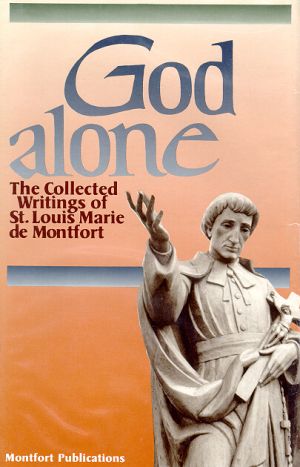
God Alone is the translation of writings of St. Louis Marie de Montfort (1673-1716), known to many primarily for his classic work on devotion to Mary. The collection includes letters, the principal works The Love of Eternal Wisdom, The Secret of Mary, True Devotion to the Blessed Virgin Mary sermons, rules for the two religious congregations he founded, and a sampling of the one hundred and sixty-three hymns he composed.
God Alone is a well-chosen title: that all spirituality is ultimately God-centered recurs frequently in these pages. In True Devotion to the Blessed Virgin Mary, St. Louis insists several times that "the purpose of devotion to Mary is to give glory to God." Mary, to whom we are dedicated, works only and always for God's glory. "You never praise or honor Mary without Mary joining you in praising and honoring God. Mary is entirely relative to God."
Throughout these pages, one senses the ardor of the preacher to the poor, the fire of the mystic, the heroism of the truly holy person. "Light and unction," he writes, "are the first requirements for perfection, for without these, others will never be attracted to the love of Wisdom." The cross requires more than resignation: to climb Mount Calvary, a person must be "courageous, heroic, and resolute." Summaries and paraphrases of the Scripture abound: "If you have trials and affliction, if you suffer much persecution for justice's sake, if you are treated as the refuse of the world, be comforted, rejoice, be glad, and dance for joy because the cross you carry is a gift so precious as to arouse the envy of the saints in heaven, were they capable of envy."
This volume of St. Louis' writings enables us to see the place Mary holds within his total spiritual perspective. His Marian writings have a rare intensity, but they are only part of a larger panorama. The Marian dimensions of St. Louis' thought are well integrated into his foundational themes of God's glory, eternal wisdom, and the cross. A listing of sermon titles for his Lenten missions reveals that only four out of seventy-six sermons are on specifically Marian topics.
Published during the Marian Year and on the fortieth anniversary of the saint's canonization, this book has explanatory notes, an index of subjects, and an index of biblical references. Attractively printed and bound, this book belongs in every library of spirituality and Marian devotion.
Jesus Living In Mary: Handbook of the Spirituality of St. Louis Marie de Montfort
-Bayshore, NY: Montfort Publications, 1994.
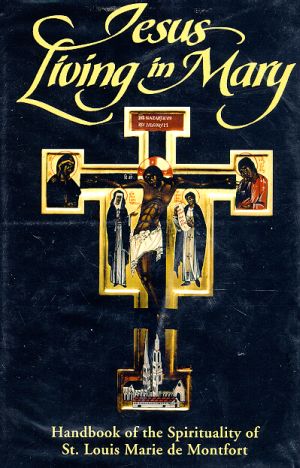
In the last few years, Catholic book publishers have produced many "handbooks" or "dictionaries" of religious information. There are dictionaries of theology, of the early church, of sacramental theology, of the social teachings of the Church, of spirituality. These summaries make accessible at a popular level information which is found only in specialized journals and works. Their appearance may stem from an awareness that we are on the threshold of a new era, and summaries of the past are needed as we enter the new period.
In 1988, the complete writings of St. Louis Grignion de Montfort appeared in the publication God Alone. Previous to this sourcebook, English readers based their opinions about Grignion de Montfort solely on his best-known work True Devotion to the Blessed Virgin, which represents only a small part of his writings. To understand de Montfort one must know his other works and the themes which permeated them: Divine Wisdom, the cross, the Holy Spirit and the times in which he lived.
Jesus Living in Mary: Handbook of the Spirituality of St. Louis Marie de Montfort provides the context for better understanding the writings of the saint. With Stefano De Fiores as general editor of the original, sixty-five scholars have contributed eighty-eight articles spanning the gamut from "Angels" to "Zeal," and including "Beauty," "Creation," "Friendship," "Hope," "Hymns," "Iconography," "Poverty," and "Tenderness."
The articles are not limited to repeating what St. Louis said on the topic. Rather a consistent attempt is made first to describe the situation in de Montfort's own time. For example, what was the significance of Baptism in seventeenth-century France? How was the Bible regarded? What place did hymn singing have? The references to de Montfort's writings are given, and, more significantly, the way in which de Montfort dealt with specific issues is described.
De Montfort's response to the pastoral challenges of his era is presented, as the Montfortian Superior General William Considine notes, so that it will provide hope and guidance to contemporary men and women seeking "to interpret Montfort's worldview and thought in light of the culture and theologies of the new millennium." All the articles are followed by abundant and annotated bibliographical references, and drastic revisions have been made in the English version since "its anticipated audience is so broadly based."
Until the publication of his collected works, St. Louis Grignion de Montfort was little known and frequently caricatured. Aspects of his Marian devotion, which may have appeared excessive, must be seen within the context of his whole spirituality. As the introduction states, the key to understanding de Montfort is to grasp that "this vagabond saint is unreservedly the world would say madly in love with Love Itself, who becames enfleshed through Mary's Yes."
Mary in Early Christian Faith and Devotion
-Stephen J. Shoemaker
-New Haven: Yale University Press, 2016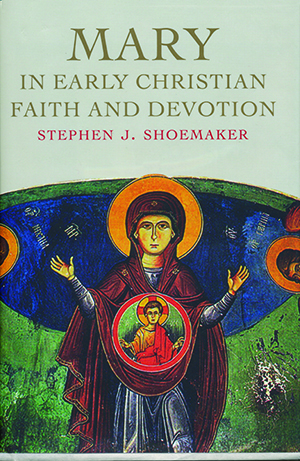
A recurring question in Marian studies deals with Marian devotion in the first four centuries of the Church. Because of the relatively few references to Mary in the early centuries, some treatises convey the impression that Marian devotion was an “innovation” in the early Church, brought about by the Council of Ephesus (431) through its proclamation of the divine motherhood (Mary as Theotokos). Or, is there more to the story that has not been uncovered?
In his past work on the dormition and assumption accounts, Stephen Shoemaker has thoroughly investigated the extant documents on Mary in the early centuries. He has a prodigious knowledge of languages. Whereas many scholars were limited to texts in Greek or Latin, Shoemaker now brings to the study references from the Ethiopic and Georgian traditions, but also from the Arabic, Armenian, Coptic, Greek, Irish, Latin, and Syriac traditions.
Now, Shoemaker asks why the dormition accounts, in addition to speaking of Mary’s final days, are not also evidence of the Marian devotion of the people in the first four centuries. Some of the texts may come from apocryphal or esoteric sources; nevertheless, they are evidence of prayer, interest, and devotion to Mary.
A popular work from the second century was the Protoevangelium of James. Originally written in Greek, it was quickly translated into Latin and other languages. The work was “the first Marian biography,” dealing with Mary’s miraculous conception; her parents, Joachim and Anna; and her presentation in the temple. The work is related not only to the infancy of Christ, but also to the holiness and purity of the Virgin Mary. The work would have great influence on the Orthodox Church and its liturgy: Of its 12 major feasts, three were found in the Protoevanglium. The Odes of Solomon are a collection of early hymns from the second century affirming Mary’s motherhood and virginity: she is a “mother with great mercies … who protected with great kindness.”
The Sub tuum praesidium is a prayer found on a fragment of a papyrus in Egypt dated toward the end of the fourth century. It became part of the Greek, Coptic, and Latin liturgies: “We take refuge beneath the protection of your compassion, O Theotokos. Do not disregard our prayers in troubling times, but deliver us from danger, O only pure and blessed one.” The prayer refers to Mary’s compassion and her intercession; it also addresses her as Theotokos (an indication that the title was in use before the Council of Ephesus). That it is written in the plural may indicate that it was a prayer used in the liturgy.
In the third and fourth centuries, evidence for Marian devotion is found in the Book of Mary’s Repose, where she is referred to as “mother of the Great Cherub of Light … Light and Mother of the Apostles.” In the Six Book Dormition Apocryphon, there are prayers for Marian intercession and references to the celebration of Marian feasts. In Jerusalem, evidence of Marian devotion can be found in the liturgy of Sunday.
Why has this devotion to the Virgin Mary on the part of the people been overlooked? In the past, Mariological studies were most interested in what the people believed, not in evidence of their belief in Mary. And, as Shoemaker mentions, the history of the early Christianity in English was written more than a century ago by academicians not favorably disposed toward Catholicism, who may have wished to consign evidence of Marian devotion to the “dustbin of popery.”
Shoemaker’s clear and convincing work, with an abundance of diverse sources, will make obsolete a generation of previous interpretation of this period. From an ecumenical viewpoint, this revisionist account affirming the presence of Marian devotion in this early period may influence how the various churches regard the first four centuries of Christianity, a period which in the past has been subject to differing interpretations in ecumenical discussion.
Mary Is for Everyone: Essays on Mary and Ecumenism
-Edited by William McLoughlin and Jill Pinnock
(available in the USA from Morehouse Publishing, PO Box 1321, Harrisburg, PA 17105).
Mary is for Everyone: Essays on Mary and Ecumenism contains the papers given at recent International Congresses of the Ecumenical Society of the Blessed Virgin Mary. The twenty-four papers, written by Orthodox, Roman Catholic, Melkite, Anglican, Presbyterian, Methodist, and Lutheran scholars, deal with Mary in the Scriptures, systematic theology, literature, and spirituality. Attention is devoted to the Malines Conversations, whose fortieth anniversary celebration in 1967 led to the establishment of the Ecumenical Society of the Blessed Virgin Mary.
Mary, Mother of God
- Carl E. Braaten & Robert W. Jenson. Eerdmans, 2004.
These essays were first presented at the "Mary, Mother of God" conference, sponsored by the Center for Catholic and Evangelical Theology, at St. Olaf College, Northfield, Minnesota, June, 2002. Recently, references to the Virgin Mary in Protestant churches are not unusual, especially during the Christmas season. These essays, however, go beyond a passing reference and ask how the Virgin Mary is related to the life of the church at this time.
Beverly Gaventa in "Nothing Will Be Impossible to God: Mary as the Mother of Believers," relates that Luke-Acts appears to create a "house-hold of believers." She asks whether Protestants can advance beyond Mary as a moral exemplar of faith to accepting her as "Mother of Believers." Mary embodies the qualities associated with "maternal thinking," that is, caring for the life, growth and strengthening of her children. Can Mary serve as "mother of believers" within the "household of believers"?
In "A Space for God," Robert W. Jensen deals with classical Protestantism's stricture against the invocation of the saints. He refers to covenanted Israel as the space inhabited by God. As the created space for God, Mary is Israel-concentrated. To invoke Mary is to take claim of, to address from within the space, God's presence within space - Israel.
David S. Yeago in "the Presence of Mary in the Mystery of the Church," with the help of John Paul II's Redemptoris Mater, proposes the formation of a "Marian consciousness" for the Church. As Mary was an "active agent" in the formation of Church at Calvary and Pentecost, so she continues as an "active agent" in the faith development of Christians. He concludes with specific suggestions - promotion of Marian feasts, and proclamation of Mary's Magnificat with "unadultered enthusiasm."
In "The Blessed Virgin Mary in Evangelical Perspective," Timothy George asks how contemporary Evangelism - heir of the Reformation, the Great Awakening, and Fundamentalism - can include a place for Mary. Biblically-based Evangelicals could agree with the Virgin-Birth, with Mary as Servant of the Lord, and with the biblically founded title of Mary as Daughter of Zion; Evangelicals who ascribe to some doctrinal development can accept Mary as Theotokos. Sadly, the essay concludes, the reason for the hesitation on the part of many Protestant churches is an "ecclesiological hardening of arteries" - developed as a response to Catholicism's Marian excesses.
Statements on Mary from Catholics, Orthodox, and Anglicans are not unusual. This collection enlarges the circle to include Lutheran, Presbyterian, Baptist, and Evangelical voices illustrating George Tavard's words that Mary can be "a unifying figure who brings often discordant voices into harmony."
The Mother of the Lord: Memory, Presence, Hope
- The Pontifical International Marian Academy
Staten Island, NY: Alba House, 2007
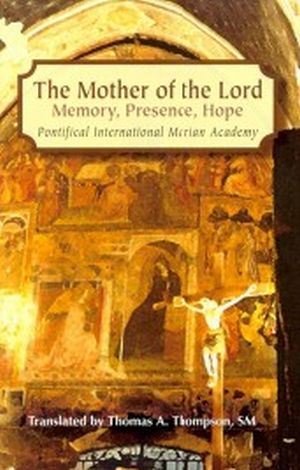
This work from the Pontificia Accademia Mariana Internationalis (PAMI) was originally published in 2000 as a letter to students and organizations that promote Marian studies. In a fraternal way, the letter proposes to chart a course for theological reflection on the Virgin Mary in the new millennium.
The work begins by establishing the context for Marian studies. At the beginning of the third millennium, the world manifests some frightening tendencies toward violence, genocide, and materialism, as well as some heartening movements toward solidarity, cooperation, and complementarity. Marian theology must speak to people within this context. One way to integrate Marian theology into contemporary theological currents is for interdisciplinary studies involving other branches of theological inquiry--soteriology, pneumatology, ecclesiology.
A second section deals with "themes and questions" to integrate the Virgin Mary not only into doctrine but also into the hearts and lives of believers--the Marian dimension of the Christian life. A third section deals with prayer in the spirit of Mary and the role that the Virgin Mary has in the Church’s liturgy and devotional life.
The letter from the Pontifical Academy is a refreshing document. It insists that reflection on the role of the Virgin Mary must speak to contemporary men and women. The centuries-old theology developed in Western Europe is not devalued or repudiated, but, at the beginning of the third millennium, "the situation has changed." People of the Third World participate in theological discourse with original insights. Women have acquired the theological status which, because of historical circumstances, was previously denied them. Ecumenism and interreligious dialogue offer new ways of dealing with traditional Marian themes. Studies of the Virgin Mary are to reflect this panoramic context presented by the pontifical academy.
A recent review in America (Nov. 19, 2007) by Nancy Hawkins expresses appreciation for many features of the work: "The historical development of Marian doctrine is explained thoroughly and clearly ... Its writing style is more inviting than the Catechism, and its conciseness makes it easy to use." But she concludes, other approaches are also needed.
"There is definitely a place on the library shelf for The Mother of the Lord, but only if it is placed next to Truly Our Sister, by Elizabeth A. Johnson, C.S.J., or another work by a contemporary Catholic theologian. The two books combined will give the reader a balanced, ecclesial and liberating vision of a graced woman of faith who has a key role to play in our lives."
New Religious Movements in the Catholic Church: Grass Roots, Mission and Evangelization
- Edited by Michael A. Hayes. London/New York: Burns & Oats, 2005.
In 1998, three-hundred thousand members of the new ecclesial movements gathered in Rome on Pentecost Sunday. In 2003-04, St. Mary's College, Twickenham, sponsored a conference on the new ecclesial movements, such as the Community of Saint Egidio, the Community of the Beatitudes, Communion and Liberation, Schoenstatt, l'Arche, Neocatechumenate Way, Sodalitium Cristianae Vitae, the Focolare. Almost all these movements were founded after Vatican II as a response to the council's "universal call to holiness." They are predominantly lay groups, seeking a "deeper spirituality," with emphasis on the Christian values in marriage and family, and commitment to community life in the Church.
Although these organizations may not have a Marian title or a specific Marian devotion, almost all have "Marian profile" embedded within their spirit and structure. Fr. Giussani, founder of Communion and Liberation, spoke of the "Mariological focus" of the Christian life and the reality of the Chruch. All Christians are called to embrace reality all the way to its mysterious origin in Christ, and to live this adherence to the mystery as a new creation. This unlimited and unconditional capacity to embrace the real identifies Mary's stance in the world. "The Virgin totally respected the freedom of God by 'saving' his freedom . . . She obeyed God because she respected His freedom without imposing her own methods."
The founder of Schoenstatt, Fr. Joseph Kentenich, wished to replace "mechanistic thinking" with an organism of attachments - which was to include persons, places, things, ideas. Central to this organism of attachments is Mary - as mother, as companion on the journey, as the one who helps to solidify the qualities of those attachments. For the Sodalitium, Mary is the "paradigmatic Christian layperson," both in prayer and in living the Gospel words. For Focolare, the image of Mary offers a spirituality "all hers" - communitarian, universal, promoting unity within communion. The Marian profile present within and lived by these ecclesial movements may well illustrate Cardinal Newman's sentiment: "In all times, the laity has been the measure of the Catholic spirit."
Praise for All Seasons: The Hymns of James Quinn S.J.
- New Brunswick, NJ: Selah Publishing Co, 1996
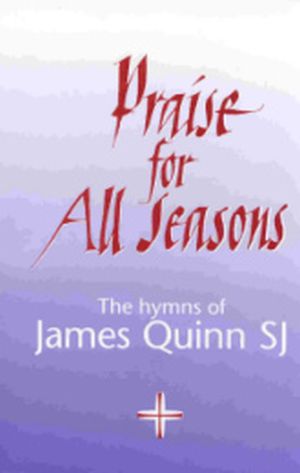
Father James Quinn, a Jesuit in Edinburgh, Scotland, is one of the finest writers of English hymn texts of our times. This collection contains over 270 of Quinn's hymns. In addition to original hymns, Quinn has written paraphrases of psalms and other verses of Scripture. His works are found in the Liturgy of the Hours and in hymnals of many denominations. (In Dakota: A Spiritual Geography, Kathleen Norris speaks of the attractive simplicity of Quinn's evening hymn, "Day is done, but Love unfailing dwells ever here," as sung in a Benedictine monastery in South Dakota.)
This collection contains thirty Marian hymns; in addition, Marian references occur in a second or third verse of a hymn directed to some other religious theme. The translations of the Salve Regina and the Alma Redemptoris Mater capture well the sense of the original. There are hymns showing Mary's relation to the paschal mystery: "The new Eve stands before the Tree,/ /the sinless mother of our race;/ /this is the hour when Adam gives/ /at Eve's request the wine of grace."
No music is given, but the meter is indicated together with suggestions for the hymn tune. The collection is a great resource for those planning liturgy, and it could also serve as a book of prayer. "All that you made is gift and grace,//by which you raise us up to you:/ /help us to know what is your will,/ /to see the false, to choose the true."
Servants of the Magnificat: The Canticle of the Blessed Virgin and the Consecrated Life
- Available from the Servite Provincialate;
3121 West Jackson Blvd.; Chicago, IL 60612.
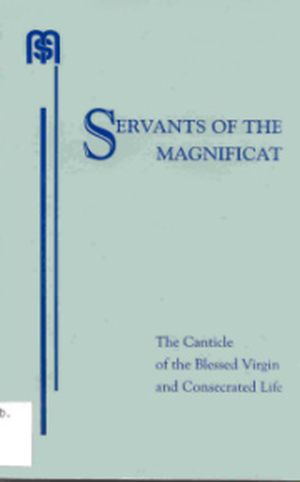
The General Chapters of the Order of the Servants of Mary (Servites) have produced two extraordinary documents on Marian devotion. The first was the 1983 document Do Whatever He Tells You, which was a perceptive analysis of the crisis of Marian devotion and its repercussions on religious institutes, together with suggestions for promoting a renewed Marian devotion.
The second document, Servants of the Magnificat, from the 1996 Servite General Chapter, can be seen as a commentary on the Marian references in the postsynodal apostolic exhortation, The Consecrated Life (1996).
In the apostolic exhortation, Mary is proposed as the model of the consecrated life. Servants of the Magnificat begins by describing four features common to Mary, the Church, and institutes of the consecrated life: consecration, vocation, radical discipleship, and mission. Mary's relation to the consecrated life--summarized under the terms of mother, patron, queen, teacher, and guide--is explained in a way sensitive to contemporary vocabulary. The last section is a reflection on the consecrated life in light of the Magnificat. A valuable resource for all interested in a deeper understanding of the Marian images and references in The Consecrated Life.
All About Mary includes a variety of content, much of which reflects the expertise, interpretations and opinions of the individual authors and not necessarily of the Marian Library or the University of Dayton. Please share feedback or suggestions with marianlibrary@udayton.edu.
